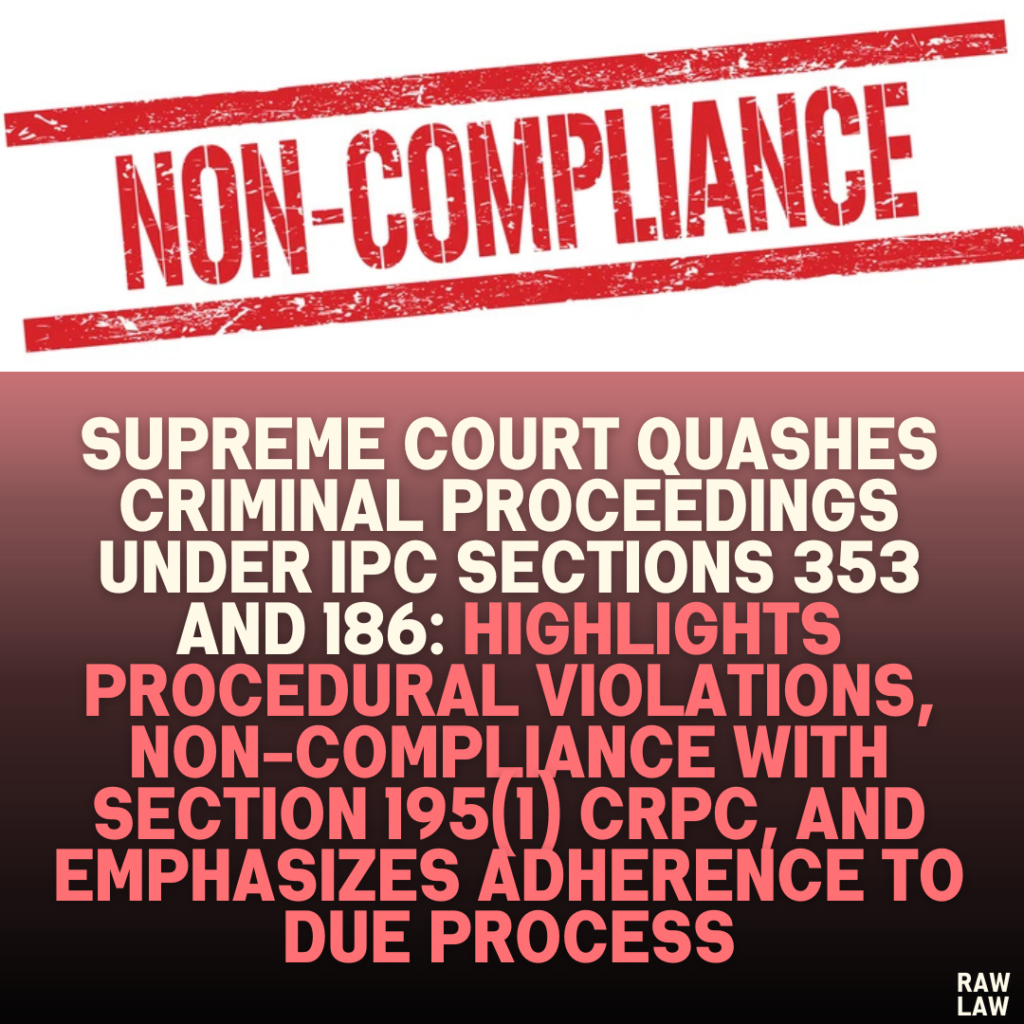Court’s Decision:
The Supreme Court quashed the criminal proceedings initiated against the appellant under Sections 353 (assault or use of criminal force to deter a public servant) and 186 (obstruction of public servant in discharge of public functions) of the Indian Penal Code (IPC). The Court held that the proceedings violated procedural requirements, particularly those under Section 195(1) of the Code of Criminal Procedure (CrPC). The judgment of the Allahabad High Court, which had dismissed the appellant’s plea to quash the proceedings, was set aside.
Facts:
- Role of the Appellant: The appellant was managing a hostel for underprivileged children under a non-governmental organization.
- The Raid and Allegations: Authorities conducted a raid on the hostel, alleging it was being run without proper authorization under the Juvenile Justice Act. During the raid, it was alleged that the appellant and his associates obstructed officials, leading to an FIR under Section 353 of the IPC.
- Subsequent Developments:
- The appellant was arrested and later released on bail.
- A chargesheet was filed, and the Chief Judicial Magistrate (CJM), Varanasi, took cognizance under Sections 353 and 186 of the IPC.
- The appellant challenged the proceedings, arguing procedural violations, but the Allahabad High Court rejected his plea.
Issues:
- Validity of Cognizance Under Section 186: Whether the absence of a prior written complaint by a public servant, as required under Section 195(1) of the CrPC, invalidated the cognizance.
- Applicability of Section 353: Whether the allegations in the FIR disclosed the use of criminal force or assault necessary to invoke Section 353.
- Procedural Compliance: Whether the proceedings adhered to the procedural safeguards prescribed under the CrPC.
Petitioner’s Arguments:
- Section 186: Cognizance of an offence under Section 186 of the IPC requires a written complaint by a public servant to a Judicial Magistrate, which was not present in this case.
- Section 353: The allegations in the FIR, even if taken at face value, did not constitute the use of criminal force or assault required under Section 353 of the IPC.
- Procedural Violations: The police improperly added Section 186 without fulfilling the statutory requirements, and the CJM’s cognizance was legally untenable.
Respondent’s Arguments:
- High Court’s Decision: The Allahabad High Court’s dismissal of the appellant’s plea was based on established principles, and no procedural violations occurred.
- Scope for Interference: The Supreme Court should not interfere with a reasoned High Court judgment unless it was perverse or illegal.
Analysis of the Law:
- Section 195(1) of the CrPC:
- Section 195(1) mandates that cognizance of certain offences, including those under Section 186 of the IPC, can only be taken based on a written complaint by a public servant.
- The Court held that no such written complaint was made in this case. The letter submitted to the City Magistrate by the District Probation Officer did not fulfill this requirement as it was addressed to an Executive Magistrate, not a Judicial Magistrate.
- Section 353 of the IPC:
- This section requires the use of criminal force or assault to deter a public servant from discharging their duty.
- The Court found that the FIR only alleged “obstruction” and lacked specific allegations of criminal force or assault. Hence, the ingredients of Section 353 were not satisfied.
- Case Law Guidance:
- State of Haryana v. Bhajan Lal established that FIRs not disclosing cognizable offences are liable to be quashed.
- State of Punjab v. Davinder Pal Singh Bhullar emphasized that procedural lapses at the initiation of proceedings invalidate subsequent actions.
Precedent Analysis:
- Relevance of Bhajan Lal Criteria:
- The Court applied the Bhajan Lal criteria to conclude that the FIR and subsequent proceedings were procedurally flawed.
- Role of Judicial vs. Executive Magistrates:
- The distinction between Judicial and Executive Magistrates, clarified in Gulam Abbas v. State of U.P., was pivotal. Complaints under Section 195(1) must be filed with Judicial Magistrates, not Executive Magistrates.
Court’s Reasoning:
- Procedural Non-Compliance:
- The FIR did not disclose a cognizable offence under Section 353, as it lacked allegations of criminal force or assault.
- The addition of Section 186 was procedurally flawed since no written complaint by a public servant was made to a Judicial Magistrate, as required under Section 195(1) of the CrPC.
- Invalidity of Cognizance:
- The cognizance taken by the CJM for both offences was contrary to law. The Court emphasized that procedural safeguards are integral to the criminal justice system.
- FIR as the Basis:
- The Court noted that the FIR, as the foundational document, must disclose the offence alleged. The absence of critical allegations undermined the proceedings.
Conclusion:
The Supreme Court quashed the proceedings under Sections 353 and 186 of the IPC, holding that the procedural lapses rendered the cognizance illegal. It also set aside the Allahabad High Court’s judgment, reaffirming the importance of procedural compliance.
Implications:
- Procedural Integrity: The judgment underscores the need for strict adherence to procedural safeguards under the CrPC.
- Protection Against Abuse: It prevents misuse of criminal provisions by ensuring that charges are substantiated by appropriate procedural compliance.
- Reinforcement of Judicial Authority: The ruling highlights the distinction between Judicial and Executive Magistrates, reaffirming their respective roles in the criminal justice system.



